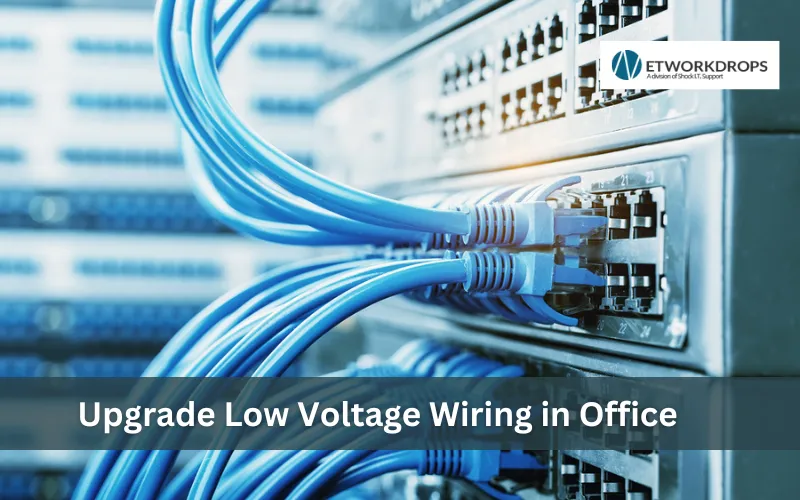
"*" indicates required fields
Upgrading your office to low-voltage wiring can significantly improve your office systems’ efficiency, safety, and performance. Whether planning a new office setup or considering a retrofit, understanding the benefits of low-voltage wiring installation can help you make informed decisions to enhance your workplace environment.
Low voltage wiring refers to electrical systems that operate at 50 volts or less. This type of wiring is commonly used for telecommunications, data transmission, security systems, and other applications where high-voltage power is not required. Examples include Ethernet cables, coaxial cables, and security camera wiring. Low-voltage systems are essential for connecting devices like computers, telephones, and audiovisual equipment in modern offices.
One of the primary advantages of low-voltage wiring installation is its energy efficiency. Low-voltage systems consume less power than traditional high-voltage systems. This reduction in power consumption can lead to significant energy savings over time, lowering your office’s overall energy bills. Using energy-efficient systems can also contribute to your office’s sustainability goals by reducing your carbon footprint.
Safety is a significant concern in any office environment. Low-voltage wiring systems inherently offer enhanced safety features compared to their high-voltage counterparts. The lower voltage reduces the risk of electric shock, making it safer for employees and maintenance personnel. Furthermore, low-voltage systems generate less heat, minimizing the risk of fire hazards. These safety benefits make low-voltage wiring an attractive option for office installations.
As businesses grow and evolve, their technological needs change. Low-voltage wiring systems provide the flexibility and scalability to adapt to these changes quickly. With low-voltage cabling, adding new devices or expanding the network is straightforward and cost-effective. This flexibility allows your office to stay current with the latest technology without requiring significant overhauls of the existing infrastructure.
Low-voltage wiring is designed to handle high-speed data transmission, which is crucial for modern office environments. With low-voltage cabling, you can achieve faster and more reliable internet connections, improved telephone systems, and enhanced audiovisual capabilities. These performance improvements can significantly enhance the efficiency and productivity of your office operations.
Upgrading to low-voltage wiring can have a direct positive impact on office productivity. Reliable and high-speed data connections ensure that employees can work efficiently without interruptions. Enhanced communication systems enable better collaboration and quicker decision-making. Moreover, improved audiovisual systems can make presentations and meetings more effective, contributing to productivity gains.
While the initial cost of low-voltage wiring installation might be a consideration, the long-term cost savings are substantial. Energy efficiency leads to lower utility bills, and the reduced risk of safety incidents can save on potential liability and insurance costs. Additionally, the ease of maintenance and scalability minimize the need for expensive upgrades and repairs in the future.
Implementing low-voltage wiring in your office requires careful planning and execution. Here are some strategies to ensure a successful upgrade:
Selecting the right low-voltage cabling provider is crucial for the success of your installation. Here are some factors to consider:
Network Drops is an excellent choice if you’re looking for a reliable low-voltage cabling provider in NJ. With years of experience and a team of certified professionals, Network Drops provides robust and efficient low-voltage wiring solutions for offices. Their services include:
Upgrading to low-voltage wiring in your office offers numerous benefits, including energy efficiency, enhanced safety, flexibility, improved performance, and cost savings. By understanding the key advantages and implementing effective strategies, you can transform your office environment to meet modern technological demands. Choosing a reputable low-voltage cabling provider like Network Drops in NJ ensures a successful and reliable installation, setting the foundation for a more efficient and productive workplace. Don’t wait—get started with low-voltage wiring installation today and experience the transformative benefits for your office.
Low voltage wiring is essential because it provides several benefits for modern office environments. It is safer than high-voltage wiring, reducing the risk of electrical shock and fire hazards. Low voltage systems are also energy-efficient, which helps lower utility costs and support sustainability goals. Additionally, low-voltage wiring supports high-speed data transmission, crucial for effective communication and technology integration in today’s offices.
Yes, low-voltage wiring is well-suited to support modern office technologies such as VoIP (Voice over Internet Protocol), IoT (Internet of Things), and cloud services. These technologies rely on high-speed data transmission, which low-voltage cabling can efficiently handle. For example, Ethernet cables, a common type of low-voltage wiring, are widely used for VoIP systems and connecting IoT devices. Low-voltage systems ensure reliable and high-performance connections essential for cloud-based applications and services.
Low-voltage wiring is highly scalable, making it an ideal choice for dynamic office environments. It allows for easy modifications and expansions as your business grows. With low-voltage wiring, you can quickly add new devices or adjust office layouts without extensive re-cabling or infrastructure changes. This scalability facilitates office layout changes by enabling flexible routing and reorganization of cables, which supports evolving workspace configurations and technology needs.
When upgrading to low-voltage wiring in an existing office, consider the following installation factors:
Low-voltage wiring contributes to environmental sustainability in several ways:
Scott Fcasni is the driving force behind Shock I.T. Support’s commercial datacomm cabling division, delivering expert solutions that power reliable, high-performance network infrastructures. With extensive experience in structured cabling and a commitment to precision, Scott ensures that every project—whether for small businesses or large enterprises—meets the highest standards of quality and scalability.